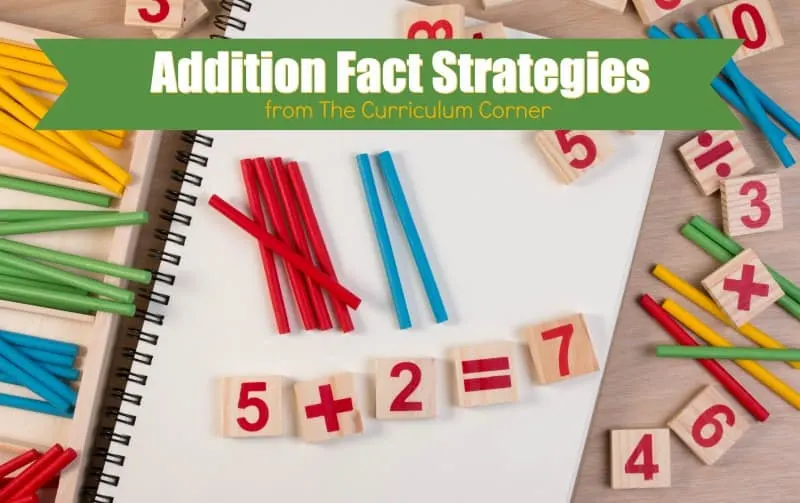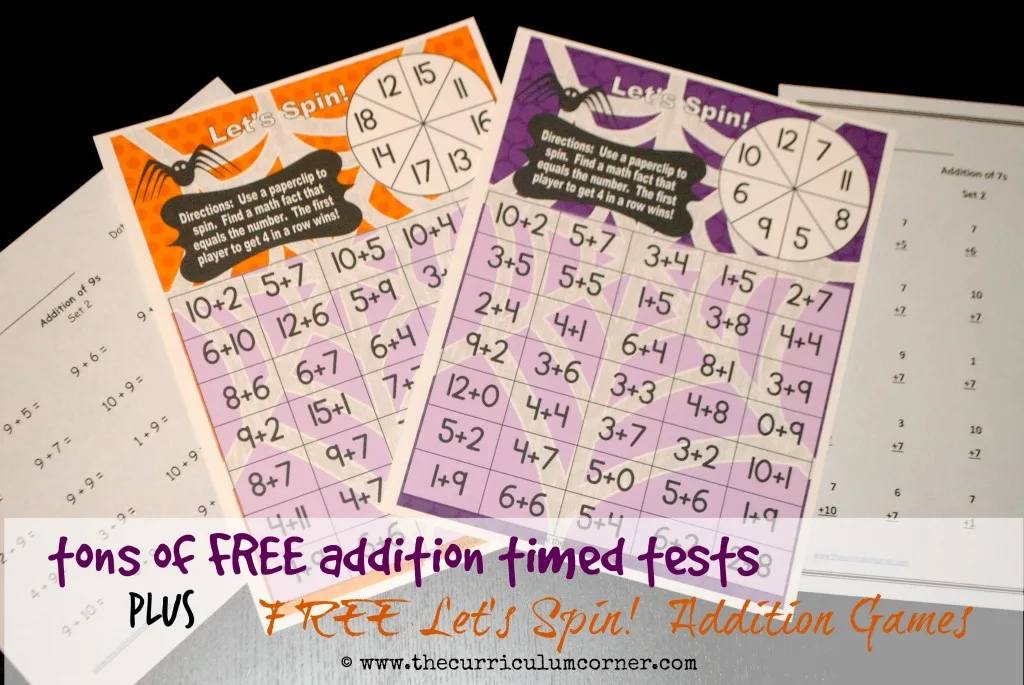These addition fact strategies will help as you are working with your students to master their addition facts.
At the bottom of this post you will find a fun set of free addition games titled “Let’s Spin”
We have had several inquiries about how we incorporate timed math facts tests in our second grade classrooms. We are sharing here how we choose to implement them with some of our favorite addition fact strategies.
Please remember, all classrooms and schools are different! What might have worked in our rooms and with the expectations we were given, might not fit your classroom.
When we are working on math fact mastery, here is how we start:
- Students begin with 0s and progress through each level all the way through 10s.
- Students will then take the 100 mixed problem test three times (with a 95% or higher score) to prove mastery.
The same procedure is followed for subtraction timed tests. If they pass those facts in the same way, then they can move on to multiplication if they are ready.
How long are students given?
We have read that research supports allowing approximately 4 seconds per problem to prove mastery. So, on the 25-problem tests we have created students would get 1 minute and 40 seconds to complete the test. At “time’s up” we allow students to put pencils down and complete any unfinished problems with a crayon. This gives them a sense of completion and also allows for a bit more practice.
The score would be all correct answers in pencil out of 25. Also, we try to give these tests three times a week if possible. Because they are so quick, it doesn’t take up much of math time.
Here is the link to the addition math fact timed tests and resources we have created:
Addition Timed Test Resources (These have been updated with both vertical and horizontal versions of the test so that you can give your students both types.)
There is lots of debate about whether or not these types of timed tests are appropriate for all kids because they can sometimes create apprehension in students.
Here are some addition fact strategies for how we help kids master math facts using these quick assessments and also to alleviate anxiety.
1. Keep it individual. Give students sticker charts to keep track of their progress and encourage them to be private about their levels. Be sure to emphasize that learning math facts is something that is mastered based on practice, but it is most certainly something in which students will progress differently. As students pass different levels let them move forward, even as others have the need to take a level again and again. One way to manage this in class is to write names on individual leveled pages before passing them out and place them face down in front of each child. This certainly won’t keep individual levels a secret, but once you start the timer, students are typically more focused on their own pages. **TIP: Don’t let students stop working if they finish early. Tell them they need to double check as many answers as they can before the time is up.**
2. Keep it motivational. Be sure to celebrate ALL successes with students when it comes to improving on or passing a level. We like to give them a one-on-one smile, compliment and pat on the back the day after a timed test. Of course we also pass out stickers for their individual charts as they pass a level as well.
3. Keep in-class practice fun. As much as possible, provide not only the time to practice in class, but make it fun by finding or making up games. There are so many ways to practice math facts that are much more fun than “kill and drill”. We have one quick and easy idea below using ordinary decks of cards and then we have also created some “Let’s Spin” games you can use.
Card Game – Give each pair of students a deck of cards with the face cards removed – but be sure there are at least two jokers in the deck to represent zeros. Students sort the cards by suit (hearts, spades, diamonds, clubs) and then each student takes two of the piles. The game is played like war. At the same time both students flip a card over. The first one to call out the correct answer gets to take both cards for their own. (This game typically requires a time limit because – just like the real card game of war – it can go on forever!)
Let’s Spin – Here are some printable games to keep it fun:
Let’s Spin Sums of 5 – 12 Color Black & White
Let’s Spin Sums of 10 – 18 Color Black & White
More than anything, remember to keep things positive, hold conferences with students to discuss frustrations and ideas for better progress, teach differentiated strategies to help all kinds of learners, communicate progress with parents and help students set personal goals for mastery.



25 Addition Facts - Mixed Review Pages - The Curriculum Corner 123
Friday 8th of February 2019
[…] look at how we created a positive environment surrounding this type of testing, check out our post: Strategies to Help Students Master Addition Math Facts. (That post also has some additional addition timed test resources you may […]
100 Addition Facts - The Curriculum Corner 123
Wednesday 6th of February 2019
[…] look at how we created a positive environment surrounding this type of testing, check out our post: Strategies to Help Students Master Addition Math Facts. (That post also has some additional addition timed test resources you may […]
Sum & Difference Sorting Cards - The Curriculum Corner 123
Tuesday 29th of May 2018
[…] Addition Fact Strategies (includes timed tests and a game) […]
Adventure Find a Fact Addition Games - The Curriculum Corner 123
Tuesday 24th of January 2017
[…] might also be interested in our multiplication facts timed test collection: Timed Tests. This post also includes links to additional free addition games along with free timed tests […]
Shannon
Friday 27th of February 2015
What do you do for kids that have LD / documented processing speed issues? Just give the same sheet untimed?
Lynn
Friday 17th of February 2017
I use time tests also. But teachers need to be careful on how they are administered. I have used them for practice only. I have a grandson who physically cannot write fast even though he knows his facts. He once asked me “why would they make you do a paper you can’t finish?” To take the test, we do the paper for the specific time and he is told how many correct out of how many he attempted rather than out of the 25 on the paper. He might get 19/19. This has eliminated his anxiety and hatred of timed tests. He is just practicing for a minute rather than trying to beat a clock that he can’t. He is a second grader. The scores are for him to see only. No big deal about them being recorded anywhere.
Jill & Cathy
Monday 2nd of March 2015
Hi Shannon and thanks for your question. Yes, we definitely differentiate for those students who have a learning disability associated with processing. The way in which we do it just depends on the children's IEPs and the specific needs of each child. Of course it is worth noting that we have also differentiated for those students who are not having success with the timed tests. We have allowed extra time, given the test one-on-one (with a volunteer or instructional assistant) to help alleviate anxiety or simply discontinued the tests and found something that works more effectively for particular students. We understand these methods are not a "one size fits all" type of thing, so each year we find what works with our specific set of students and needs.